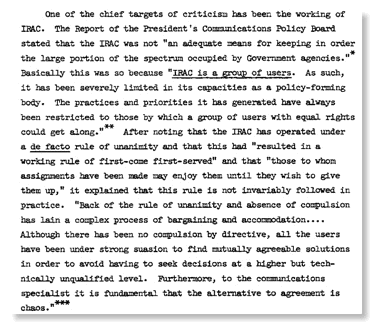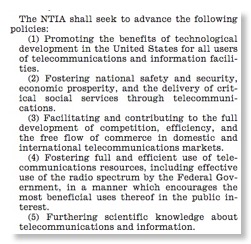Federal Spectrum Reform in the Next Administration
In practice, IRAC has had a major role in federal spectrum policy development and the top leadership of NTIA rarely overrules its decisions. Indeed, having sat in on may IRAC meetings it is clear that in the view of many IRAC members, NTIA is the law firm that represents their views to FCC and Congress and its not a regulatory agency. These members also tend to view the NTIA Office of Spectrum Management as the "IRAC Secretariat" -implementing the will of IRAC and recording the spectrum assignments that it has approved. Indeed a review of the spectrum report coauthored by Nobel laureate Ronald Coase in the early 1960s, "Problems of Radio Frequency Allocation" shows not much has changed int eh decades since it was written. In particular, the section entitled "The Work of the Interdepartment Radio Advisory Committee" may be the most accurate description of how IRAC worked publicly available although there have been some minor changes over the decades. Here is a section from the Coase report:
.
Would the pending MOBILE NOW Act and previously congressionally mandated reallocations of federal spectrum to nonfederal use have been necessary of NTIA and FCC had been working together in the national interest? Do the delays and uncertainties of needing Congress to act on these impose real costs on economic growth? While the cellular industry has the political influence to get legislative support for such reallocations, other spectrum users may not - particularly those in the early stages of their business plans - do not have enough political influence but may have significant economic potential.
The irony is that the congressionally mandated reallocations of the past 2 decades have resulted in antagonisms against reallocation of federal spectrum to non federal government users so requests for access to federal spectrum from less politically connected parties tend to get at best a slow response from NTIA.
I even had a client who was a military contractor who requested brief access to passive spectrum near 100 GHz that had no interference risk to any actual passive systems and the initial application was rejected by NTIA because one IRAC member did like the idea of it. It took a month of a DoD IRAC member beating up on the objecting IRAC member before be finally relented and dropped his objection. It did not appear that during this pendency any NTIA employees ever asked the objecting agency for a "reality check" to see if there was any technical merit to their objection. If this is how they handle requests of military contractors, imagine how privately funded research from non-CTIA members is handled?
FCC Reform in the Next Administration - Part 1
These posts will focus on spectrum policy issues and innovation. While net neutrality, privacy and competition are key issues, many others speak on them and they will not be addressed here.
For the first posting let me point out the spectrum policy recommendations that have been made by IEEE-USA, the US arm of the transnational electrical engineering society that covers all the technical aspects of FCC jurisdiction. These are in a document entitled "Improving U.S. Spectrum Policy Deliberations in the Period 2017-2021". Although they focus on FCC, some also address related NTIA federal spectrum management issues because FCC's §301 jurisdiction is so closely connected to NTIA's delegated authority of §305. The recommendations are in 3 different areas. Below offer the areas and the basic commendations in each. More discussion is in the IEEE-USA document.
Process Improvement:
- FCC and NTIA should explicitly acknowledge the role of Section 7 of the Communications Act of 1934, as amended, and the intent of Congress to encourage new communications technology and services. These agencies should adopt transparent procedures for determining which innovations are subject to this statute and should make readily available information on such proceedings. The FCC and NTIA should recommend changes in the statute in a timely way, if the current terms of Section 7 are deemed not practical.
- Petitions for rule changes and clarifications are key issues in the regulation of the dynamic telecommunications industry. FCC should act on such petitions in a more transparent way, and make available information on petitions and their status on a consistent timely schedule.
Improved technical resources for FCC and NTIA to improve decision making:
- In selecting presidential appointments to FCC, NTIA, and the State Department in communications policy functions consideration should be given to individuals with experience in information and communications technology (ICT), to balance the backgrounds of the officials in these key positions.
- FCC commissioners should consider appointing individuals with experience in information and communications technology (ICT). as one of their three assistants, allowed by law.
- FCC and NTIA should supplement their existing Technological Advisory Council (TAC) and Commerce Spectrum Management Advisory Committee (CSMAC), which consist mainly of representatives of major communications firms, with a new advisory committee that serves both agencies and focuses on independent review of options for resolving spectrum conflicts and identifying outdated policies. The new group should be modeled on the EPA Science Advisory Board and the NRC Advisory Committee on Reactor Safeguards and members should have the necessary security clearances to deal with issues involving classified federal government spectrum users, if so requested.
- FCC and NTIA should have the resources to contract with the National Academy of Science’s National Research Council (NAS/NRC), Federally Funded Research and Development Centers (FFRDCs) and private analysis contractors, to supplement their internal staffs on novel technical policy questions where they lack the appropriate internal resources.
- The NTIA and FCC technical staffs are key to the long-term success of U.S. spectrum policy. Recruiting and developing the careers of these personnel should be done using the best practices of other agencies involved in technical policy development.
Other Issues to Stimulate Innovation:
- The executive branch should act to review and implement the recommendations for federal spectrum management reform in Sections 5.2 – 5.6 of the July 2012 President's Council of Advisors on Science and Technology (PCAST) report, “Realizing the Full Potential of Government-Held Spectrum,” to facilitate the reallocation and sharing of federal spectrum for private sector use.
- FCC and NTIA should review, and consider adopting the IEEE-USA recommendations for clarifying harmful interference.
- FCC should complete action in a timely way on Docket 09-157, which deals with wireless technical innovation.




![Validate my RSS feed [Valid RSS]](valid-rss-rogers.png)

